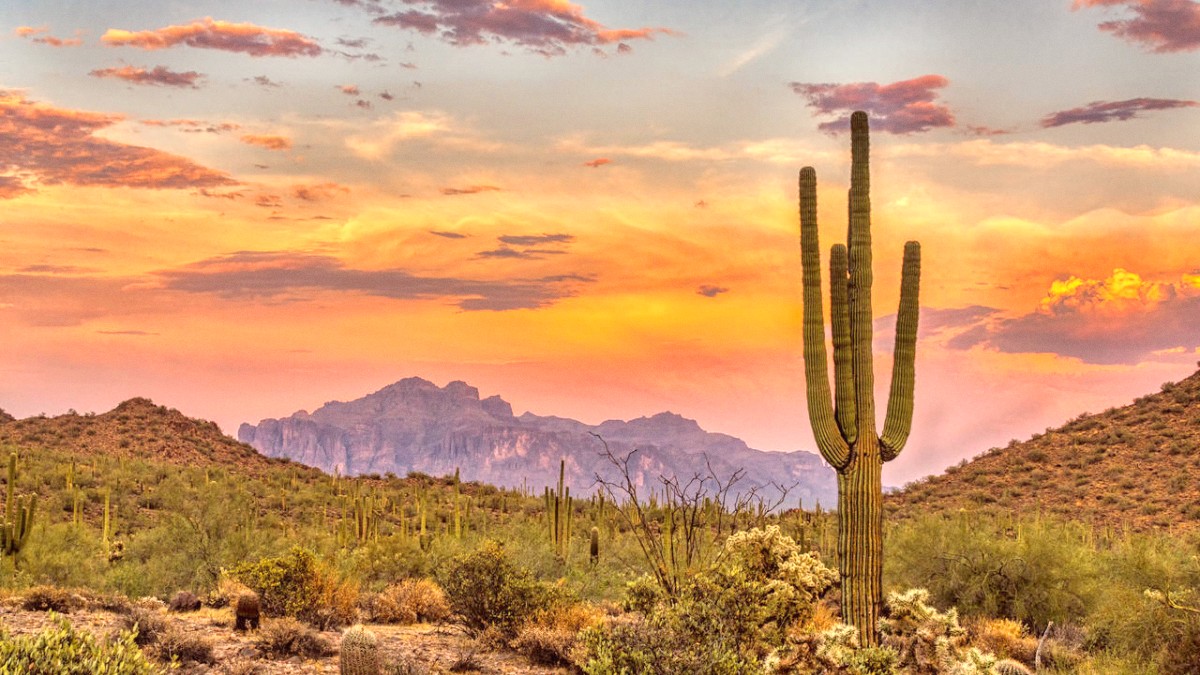
Southwest, USA
Climate patterns throughout the year (temperature, precipitation, humidity)
Winter (November-March): This period brings mild temperatures. Daily ranges typically go from 40-70°F (4-21°C). Humidity stays low. This is the sunniest time of year, with abundant clear skies. Days are enjoyable for outdoor activities, while evenings can be cool.
Precipitation is low for most of the year. A distinct "monsoon season" occurs from mid-June to mid-September. These monsoon rains can be intense but typically short-lived.
They often bring dramatic skies and refreshing coolness after the heat.
November - April
Ideal weather for outdoor activities. Many events and festivals.
Higher accommodation prices, crowded attractions, expensive flights.
May, October
Pleasant temperatures, fewer crowds, lower prices for flights and hotels.
May starts to get hot. Some seasonal attractions might have reduced hours.
June - September
Accommodation and flight prices are significantly lower. Fewer tourists. Dramatic monsoon thunderstorms.
Extreme heat (often 100°F+). Outdoor activities for early morning/late evening. Increased humidity during monsoon.
From mid-June to mid-September, Tucson experiences the North American Monsoon. This weather pattern yields dramatic afternoon and evening thunderstorms. These storms create high humidity, flash floods, and dust storms, locally known as haboobs. While brief, these storms are intense. They impact travel plans or outdoor activities. Always monitor weather forecasts during this period. Never drive through flooded roads.
Summer temperatures consistently reach extreme highs. Hydration is . Sun protection too. Limit strenuous outdoor activity during the hottest parts of the day.
Mid-June to mid-September. Flash floods and dust storms (haboobs) are common.
June to September. Daily highs often over 100°F (38°C).
Tucson is inland, so direct hurricane impact is not a concern.
Dry periods in spring/early summer. Check local alerts.
Year-round intense sun. Sunscreen and protective clothing advised.
Travel to the United States calls for specific documentation. Understand the requirements based on your nationality. Proper preparation can prevent issues upon arrival.
Most international travelers visiting the United States for tourism need a B-2 non-immigrant visa. Alternatively, they meet qualifications for the Visa Waiver Program (VWP) through an approved Electronic System for Travel Authorization (ESTA) application.
You must show proof of your intent to leave the U.S. This typically means a confirmed return or onward flight ticket.
Upon arrival at an U.S. Port of entry, travelers undergo inspection by U.S. Customs and Border Protection (CBP) officers.
ESTA application costs $21.00 USD, paid online. Visa application fees vary by type and nationality (e.g., B1/B2 tourist visas cost $185 USD), paid before the interview.
No special permits are generally required for standard tourism activities in Tucson. Most attractions, museums, and public spaces do not require permits beyond their regular admission fees. However, if you plan specific backcountry camping within Saguaro National Park or Coronado National Forest, you will need permits. Always check with the relevant park services directly for current regulations.
Includes fingerprinting and photographs.
Officers may ask about trip purpose, duration, and accommodation.
Answer truthfully and calmly to verify identity and meet entry requirements.
Generally none for standard tourism activities in Tucson.
Needed for Saguaro National Park or Coronado National Forest backcountry camping.
Prices vary significantly based on your travel style and preferences.
The official currency in the United States is the United States Dollar (USD or $).
Detailed cost breakdown for different travel styles:
| Category | Description | Price Range (USD) |
|---|---|---|
| Accommodation | Hostels to Luxury Resorts | $30-$500+ / night |
| Meals | Street food to Fine Dining | $8-$150+ / meal |
| Transportation | Bus, Ride-share, Car Rental | $1.75-$100+ / day |
No specific vaccinations are necessary for entry to the U.S. From most countries. Ensure your routine vaccinations are up to date.
These are common in summer and even in mild seasons due to the dry desert air.
The desert sun is intense year-round.
Rattlesnakes, scorpions, javelinas, and other creatures live in the desert.
Always monitor weather forecasts during this period. Never drive through flooded roads.
Drink plenty of water. Avoid strenuous activity during midday heat. Wear wide-brimmed hats and lightweight, light-colored clothing.
Use broad-spectrum sunscreen SPF 30+. Apply frequently. Wear protective clothing and UV-protective sunglasses.
Watch your step, especially when hiking. Do not approach wildlife. Inspect shoes before putting them on.
Dial 911 for police, fire, or medical emergencies. This is a free call from any phone (landline or mobile).
For non-life-threatening issues like minor injuries, colds, or flu, urgent care clinics offer a quicker and less expensive alternative to emergency rooms.
Major pharmacy chains like CVS and Walgreens are widely available. They can fill prescriptions and offer a range of over-the-counter medications.
Tucson is generally safe for tourists. As in any city, you should exercise caution.
From mid-June to mid-September, Tucson experiences the North American Monsoon. This weather pattern brings dramatic afternoon and evening thunderstorms.
A risk during monsoon season. Avoid washes and low-lying areas during heavy rain.
June to September brings extreme heat. Vigilance regarding hydration and sun exposure is needed.
During dry periods in spring/early summer. Check local alerts if hiking in remote areas.